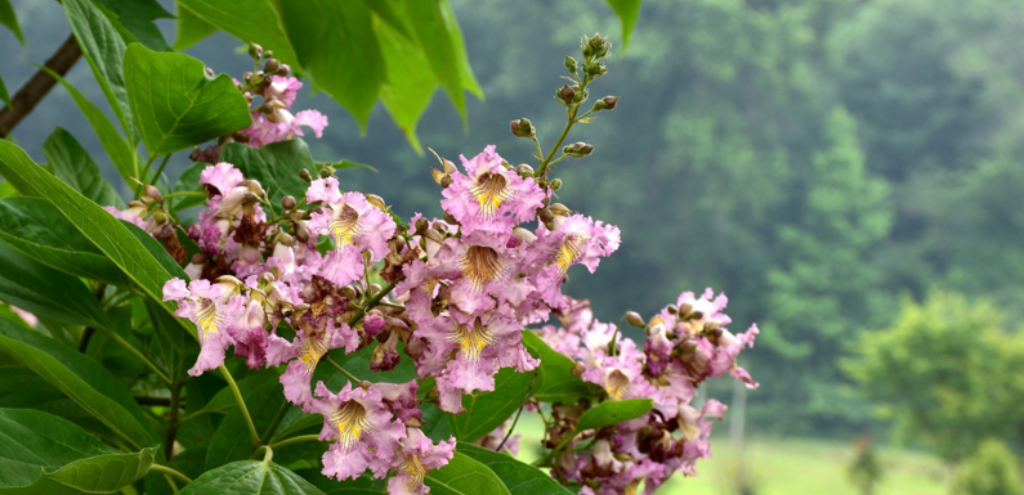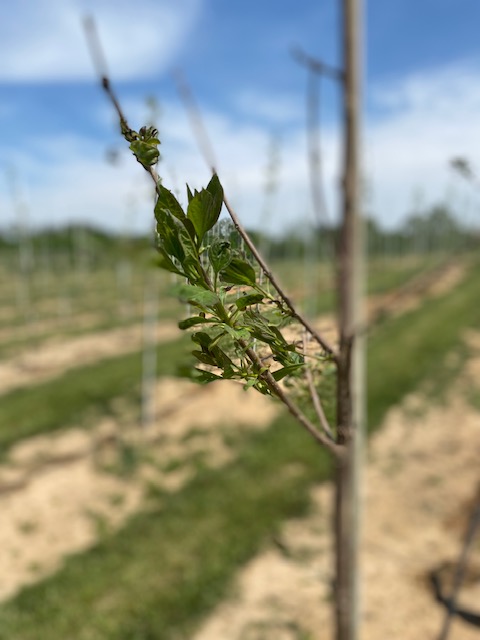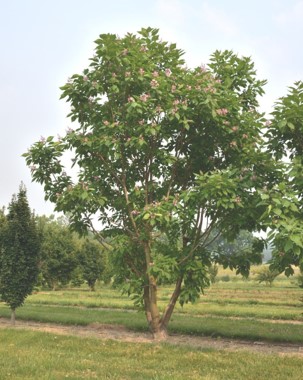THE LEAFLET

Strawberry Moon Chitalpa Blooms at the Casey Tree Farm
Exciting news is budding at the Casey Trees Farm as it welcomes a charming addition to its arboreal family: the Strawberry Moon Chitalpa (×Chitalpa tashkentensis ‘Strawberry Moon’)! This captivating species is the culmination of over 20 years of meticulous research and dedicated hybridization efforts, resulting in a tree that promises to enchant urban and suburban landscapes alike.
The story of the Strawberry Moon Chitalpa / Casey Trees meet cute begins with a lucky encounter at the Mid-Atlantic Nursery Trade Show (MANTS). Representatives from the Casey Trees Farm attended the event, stumbled upon information about the Chitalpa species, and were immediately captivated. Inspired by what they learned, they took the steps to order some for planting at Casey Trees Farm and recently planted 50 trees that will be ready for harvest and use in the urban landscape as early as next year.
Recently, we spoke to Dr. Richard T. Olsen, the mastermind behind this botanical triumph, who spearheaded the hybridization research. His journey began during his tenure as a PhD student at North Carolina State University and continued as a plant geneticist at the National Arboretum. Dr. Olsen’s vision and expertise paved the way for the creation of the Strawberry Moon Chitalpa, showcasing the intersection of science and horticultural innovation.
Dr. Olsen emphasized the National Arboretum’s role as a hub for tree research and education. He clarified, “We’re a collections-based research garden, a science and research-based institution.” With over 22,000 documented trees and plants from around the world, the Arboretum serves as a treasure trove of botanical diversity. “Those trees that people see out there are not just around to be pretty, they’re actually a documented scientific collection. We just happen to plant them out to make them look pretty instead of in boring scientific rows.”
This unique species originated from a carefully controlled cross conducted at the National Arboretum back in 2008, but even that was the result of many years of work and research. “I actually conceived of Strawberry Moon during my PhD in 2002, the cross that led to Strawberry Moon was finally able to be done in 2007 and then it was [recently] released in 2023. So, that was 21 years from conception to release – tree breeding is a long-term investment,” Dr. Olsen shared.
The breeding process involved combining the tetraploid Pink Dawn Chitalpa (×Chitalpa tashkentensis ‘Pink Dawn’) with the diploid Chinese catalpa (Catalpa ovata). The objective was to produce a tree with improved characteristics, including vibrant pink flowers, enhanced powdery mildew resistance, and a more appealing tree form.
“The notion was, how can we create this tree with all the traits that urban tree planters want? A lot of urban tree planters want the same thing that everyone else wants – they want showiness, they want the trees to be tough and adaptable, and then they don’t want them to be invasive or have a messy litter of fruit. And although catalpa naturally can have a lot of fruit on it and can be messy, we can take care of that through hybridization. We can make it sterile. Oftentimes when you cross plants, they’re close enough that you can breed them, but they’re not related enough to be able to have offspring. A more popular example of this is a mule. Mules are a cross between a horse and a donkey, but the mule can’t reproduce, it’s sterile. So, we sort of played with that concept and figured out how we can get up to this goal of a better catalpa” Olsen said.
 Following the cross, a meticulous evaluation process ensued, with 42 seedlings from the initial trial planted for assessment in July 2010. After years of observation and selection, the standout candidate emerged: the Strawberry Moon Chitalpa. Recognized for its deeper pink blossoms, reduced fruit set, and smaller foliage size, this tree represents a significant advancement in chitalpa breeding.
Following the cross, a meticulous evaluation process ensued, with 42 seedlings from the initial trial planted for assessment in July 2010. After years of observation and selection, the standout candidate emerged: the Strawberry Moon Chitalpa. Recognized for its deeper pink blossoms, reduced fruit set, and smaller foliage size, this tree represents a significant advancement in chitalpa breeding.
Delving into the physical process of tree breeding, Dr. Olsen shed light on the practicalities of pollen transfer. He explained, “Naturally, it’s all about putting pollen to pistol, using a paintbrush and transferring pollen to another one.” This hands-on approach in the greenhouse underscores the meticulous work required in hybridization efforts.
When it comes to christening a newly created species, Dr. Olsen revealed that the honor typically falls to the inventor. But seeing as the creation spanned two decades and numerous teammates, it only felt fair to find a name everyone could appreciate. Reflecting on the naming process, he shared, “I like things that have a deeper meaning. The name ‘Strawberry Moon’ holds significance, paying homage to Native American traditions.” Dr. Olsen elaborated, “A nod to the Native American term for the first moon of June, the Strawberry moon occurs when strawberries are ripe, and also when this tree blooms.” This year’s strawberry moon rises on June 21, 2024, a day after the summer solstice.
 With its ornamental appeal and practical advantages, the Strawberry Moon Chitalpa is poised to become a staple in urban and suburban landscapes. Its reduced litter and improved tree form make it an ideal choice for those seeking both beauty and ease of maintenance in their green spaces.
With its ornamental appeal and practical advantages, the Strawberry Moon Chitalpa is poised to become a staple in urban and suburban landscapes. Its reduced litter and improved tree form make it an ideal choice for those seeking both beauty and ease of maintenance in their green spaces.


